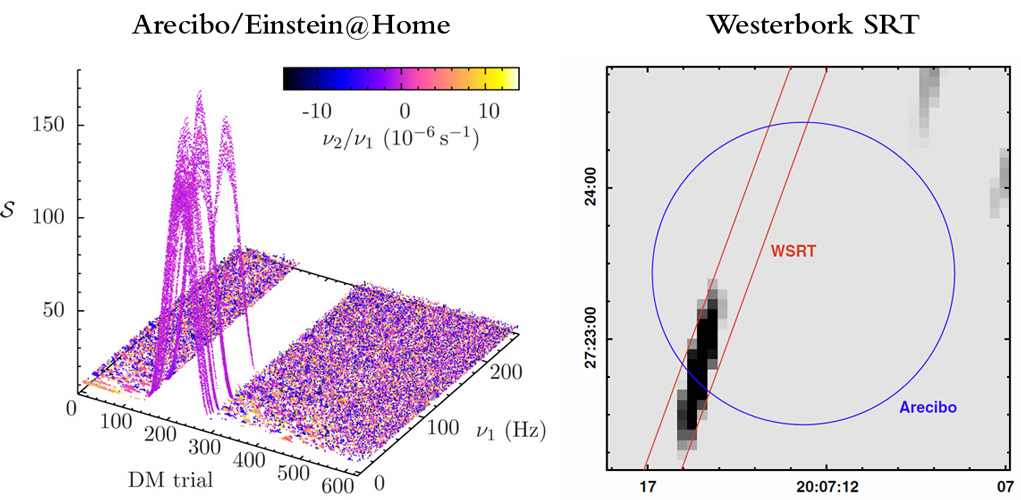Daily Image
23-08-2013The Einstein @ Home discovery of pulsar J2007+2722
| Submitter: | Joeri van Leeuwen, George Heald & Jason Hessels |
| Description: | Einstein@Home aggregates the computer power of hundreds of thousands of volunteers from 193 countries, to search for new neutron stars using data from electromagnetic and gravitational-wave detectors. A paper led by Bruce Allen (MPI Gravitationsphysik) and including ASTRON astronomers Jason Hessels, George Heald and Joeri van Leeuwen that appears in the August volume of ApJ, presents a detailed description of the search for new radio pulsars using Pulsar ALFA survey data from the Arecibo Observatory. The enormous computing power allows this search to cover a new region of parameter space; it can detect pulsars in binary systems with orbital periods as short as 11 minutes. The paper describes the first Einstein@Home discovery, the 40.8 Hz isolated pulsar PSR J2007+2722. The left-hand subpanel shows the visualization of the discovery space. The detection significance S is plotted as a function of the dispersion-measure trial number and the pulsar spin frequency. The pulsar is clearly detected at a DM of 127 pc/cc and a period of 24.4 milliseconds. PSR J2007+2722 pulse profile is remarkably wide with emission over almost the entire spin period. The fine localization of J2007+2722 was provided by Westerbork. In the right sub-panel, the blue error circle was obtained by Arecibo gridding. In red is shown the WSRT/PuMaII error region obtained by overlapping fan beams, and looking for the dedispersed, folded pulsar period signal in each. In ten 1180s observations the position could thus quickly be much refined. We believe this is the first time that WSRT has been used for pulsar position refinement in this way. Simultaneously with pulsar data, WSRT imaging data were also acquired. This data is shown in the gray scale. As only a single radio source is visible on the southern side of the error ellipse, we conclude this too is the pulsar. The source corresponds to a cataloged NVSS source and from the long-term timing position we find it is indeed PSR J2007+2722. This neutron star is most likely a disrupted recycled pulsar, about as old as its characteristic spin-down age of 404 Myr. |
| Copyright: | ApJ |
| Tweet |  |
